Study on the Performance of Phase-Change Self-Regulating Permeable Asphalt Pavement
Abstract
:1. Introduction
2. Materials and Methodology
2.1. Materials
2.1.1. Paraffin-Based Phase-Change Materials
2.1.2. Asphalt
2.1.3. Aggregates and Mineral Powder
2.2. Test Methods
2.2.1. Three Major Indicator Tests
2.2.2. DSR Test
- S(t)—Creep stiffness modulus (MPa) at 60 s;
- P—Load 100 g;
- L—Beam spacing 102 mm;
- b—Beam width 12.5 mm;
- h—Beam height 6.25 mm;
- δ(t)—Deflection (mm) when time equals 60 s.
2.2.3. Ice Formation Test
2.2.4. Mixture Test
- (1)
- Thermal Conductivity Testing of Phase-Change Porous Asphalt Mixture
- (2)
- The Deicing and Snow-Melting Performance of Phase-Change Porous Asphalt Mixture.
3. Results and Discussion
3.1. Performance Analysis of Phase-Change High-Viscosity Asphalt
3.1.1. Basic Properties of Phase-Change High-Viscosity Asphalt
3.1.2. Analysis of Anti-Icing Performance of Phase-Change High-Viscosity Asphalt
- (1)
- Observation of Surface Ice Formation Process of Asphalt Binder at −2.5 °C
- (2)
- Observation of Surface Ice Formation Process of Asphalt Binder at −5 °C
3.1.3. Study on Rheological Properties of Phase-Change High-Viscosity Asphalt
- (1)
- PG High-Temperature Grading Test
- (2)
- Low-Temperature Bending Rheological Test Analysis
- (3)
- Temperature Sweep Test
3.2. Effect of Phase-Change Materials on Mix Properties
3.2.1. Phase-Change Permeable Asphalt Mixture Thermal Properties Research
- (1)
- Research on thermal conductivity of phase-change permeable asphalt mixtures
- (2)
- Phase-change permeable asphalt mixture snow-melting performance research
3.2.2. Research on Road Performance of Phase-Change Permeable Asphalt Mixture
4. Conclusions
Author Contributions
Funding
Conflicts of Interest
References
- Dou, G.; Sun, G.; Tan, X.; Xie, Q.; Liu, Y.; Wu, Y. Temperature Regulation Mechanism of Asphalt Pavement and Active Ice and Snow Melting Technology in Cold Plateau Areas: A Review. In Proceedings of the CICTP 2020, Xi’an, China, 14–16 August 2020; pp. 2046–2057. [Google Scholar]
- Yang, M.; Zhang, X.; Zhou, X.; Liu, B.; Wang, X.; Lin, X. Research and exploration of phase change materials on solar pavement and asphalt pavement: A review. J. Energy Storage 2021, 35, 102246. [Google Scholar] [CrossRef]
- Wang, H.-R.; Wang, Y.-M.; Qi, M.-L.; Wang, Q.-L.; Li, X.; Zhu, X.-X.; Yu, X.-Q.; Liu, Z.-M. PEG/diatomite modified Asphalt Mixture with Self-Regulating temperature property. Case Stud. Constr. Mater. 2021, 15, e00585. [Google Scholar] [CrossRef]
- Wu, L.; Liu, Q.; Tang, N.; Wang, X.; Gao, L.; Wang, Q.; Lv, G.; Hu, L. Development of two-dimensional nano Mts/SA phase change materials for self-adjusting temperature of pavement. Constr. Build. Mater. 2022, 349, 128753. [Google Scholar] [CrossRef]
- Xu, P.; Zhang, D.; Miao, Y.; Sani, B.M.; Zhang, K. Development and characterization of a novel steel slag-based composite phase change aggregate for snow/ice melting of asphalt pavements. Constr. Build. Mater. 2022, 341, 127769. [Google Scholar] [CrossRef]
- Wang, S.; Wei, K.; Shi, W.; Cheng, P.; Shi, J.; Ma, B. Study on the rheological properties and phase-change temperature regulation of asphalt modified by high/low-temperature phase change material particles. J. Energy Storage 2022, 56, 105970. [Google Scholar] [CrossRef]
- Jin, J.; Xiao, T.; Zheng, J.; Liu, R.; Qian, G.; Xie, J.; Wei, H.; Zhang, J.; Liu, H. Preparation and thermal properties of encapsulated ceramsite-supported phase change materials used in asphalt pavements. Constr. Build. Mater. 2018, 190, 235–245. [Google Scholar] [CrossRef]
- Chen, M.Z.; Hong, J.; Wu, S.P.; Lu, W.; Xu, G.J. Optimization of phase change materials used in asphalt pavement to prevent rutting. Adv. Mater. Res. 2011, 219, 1375–1378. [Google Scholar] [CrossRef]
- Jia, M.; Sha, A.; Jiang, W.; Li, X.; Jiao, W. Developing a solid–solid phase change heat storage asphalt pavement material and its application as functional filler for cooling asphalt pavement. Energy Build. 2023, 285, 112935. [Google Scholar] [CrossRef]
- Dai, J.; Ma, F.; Fu, Z.; Li, C.; Wu, D.; Shi, K.; Dong, W.; Wen, Y.; Jia, M. Assessing the direct interaction of asphalt binder with stearic acid/palmitic acid binary eutectic phase change material. Constr. Build. Mater. 2022, 320, 126251. [Google Scholar] [CrossRef]
- Jiao, W.; Sha, A.; Zhang, J.; Jia, M.; Jiang, W.; Hu, L. Design and properties of polyurethane solid–solid phase-change granular temperature regulation asphalt mixtures. Sol. Energy 2023, 253, 47–57. [Google Scholar] [CrossRef]
- Bian, X.; Tan, Y.Q.; Lv, J.F.; Shan, L.Y. In Preparation of latent heat materials used in asphalt pavement and theirs’ controlling temperature performance. In Advanced Engineering Forum; Trans Tech Publications: Wollerau, Switzerland, 2012; pp. 322–327. [Google Scholar]
- Yuan, J.; He, P.; Li, H.; Xu, X.; Sun, W. Preparation and Performance Analysis of Ceramsite Asphalt Mixture with Phase-Change Material. Materials 2022, 15, 6021. [Google Scholar] [CrossRef] [PubMed]
- Wang, X.; Ma, B.; Li, S.; Si, W.; Wei, K.; Zhang, H.; Zhou, X.; Fang, Y.; Kang, X.; Shi, W. Review on application of phase change materials in asphalt pavement. J. Traffic Transp. Eng. (Engl. Ed.) 2023, 10, 185–229. [Google Scholar] [CrossRef]
- Zhang, D.; Chen, M.; Wu, S.; Liu, Q.; Wan, J. Preparation of expanded graphite/polyethylene glycol composite phase change material for thermoregulation of asphalt binder. Constr. Build. Mater. 2018, 169, 513–521. [Google Scholar] [CrossRef]
- Ma, B.; Li, J.; Liu, R.W.; Ma, J. Study on road performance of phase-change temperature-adjusting asphalt mixture. Adv. Mater. Res. 2011, 287, 978–981. [Google Scholar] [CrossRef]
- Wang, T.; Weng, Y.; Cai, X.; Li, J.; Xiao, F.; Sun, G.; Zhang, F. Statistical modeling of low-temperature properties and FTIR spectra of crumb rubber modified asphalts considering SARA fractions. J. Clean. Prod. 2022, 374, 134016. [Google Scholar] [CrossRef]
- Yan, Q.; Liu, C.; Zhang, J. Experimental study on thermal conductivity of composite phase change material of fatty acid and paraffin. Mater. Res. Express 2019, 6, 065507. [Google Scholar] [CrossRef]
- Zhang, D.; Bu, W.K.; Wang, Q.Y.; Liu, P.P.; Shao, Z.H.; Liu, X.F.; Li, G.Y.; Zhou, Y. A review of recent developments and challenges of using phase change materials for thermoregulation in asphalt pavements. Constr. Build. Mater. 2023, 400, 132669. [Google Scholar] [CrossRef]
- Cui, Y.; Xie, J.; Liu, J.; Wang, J.; Chen, S. A review on phase change material application in building. Adv. Mech. Eng. 2017, 9, 1687814017700828. [Google Scholar] [CrossRef]
- Chen, Y.; Wang, H.; You, Z.; Hossiney, N. Application of phase change material in asphalt mixture—A review. Constr. Build. Mater. 2020, 263, 120219. [Google Scholar] [CrossRef]
- Wei, C.; Shao, J.; Darkwa, J. Experimental investigations into thermal performance of phase change emulsion in a fin-and-tube heat exchanger. Int. J. Low-Carbon Technol. 2023, 18, 175–183. [Google Scholar] [CrossRef]
- Guo, M.; Liang, M.; Jiao, Y.; Zhao, W.; Duan, Y.; Liu, H. A review of phase change materials in asphalt binder and asphalt mixture. Constr. Build. Mater. 2020, 258, 119565. [Google Scholar] [CrossRef]
- Athukorallage, B.; Dissanayaka, T.; Senadheera, S.; James, D. Performance analysis of incorporating phase change materials in asphalt concrete pavements. Constr. Build. Mater. 2018, 164, 419–432. [Google Scholar] [CrossRef]
- Du, Y.; Liu, P.; Wang, J.; Wang, H.; Hu, S.; Tian, J.; Li, Y. Laboratory investigation of phase change effect of polyethylene glycolon on asphalt binder and mixture performance. Constr. Build. Mater. 2019, 212, 1–9. [Google Scholar] [CrossRef]
- Kousksou, T.; Jamil, A.; El Rhafiki, T.; Zeraouli, Y. Paraffin wax mixtures as phase change materials. Sol. Energy Mater. Sol. Cells 2010, 94, 2158–2165. [Google Scholar] [CrossRef]
- Liu, Z.; Zhou, Z.; Gu, X.; Sun, L.; Wang, C. Laboratory evaluation of the performance of reclaimed asphalt mixed with composite crumb rubber-modified asphalt: Reconciling relatively high content of RAP and virgin asphalt. Int. J. Pavement Eng. 2023, 24, 2217320. [Google Scholar] [CrossRef]
- Xing, C.; Li, M.; Liu, L.; Lu, R.; Liu, N.; Wu, W.; Yuan, D. A comprehensive review on the blending condition between virgin and RAP asphalt binders in hot recycled asphalt mixtures: Mechanisms, evaluation methods, and influencing factors. J. Clean. Prod. 2023, 398, 136515. [Google Scholar] [CrossRef]
- Wang, T.; Xiao, F.; Amirkhanian, S.; Huang, W.; Zheng, M. A review on low temperature performances of rubberized asphalt materials. Constr. Build. Mater. 2017, 145, 483–505. [Google Scholar] [CrossRef]
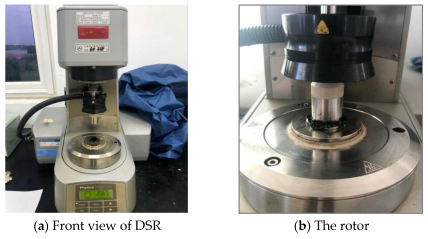
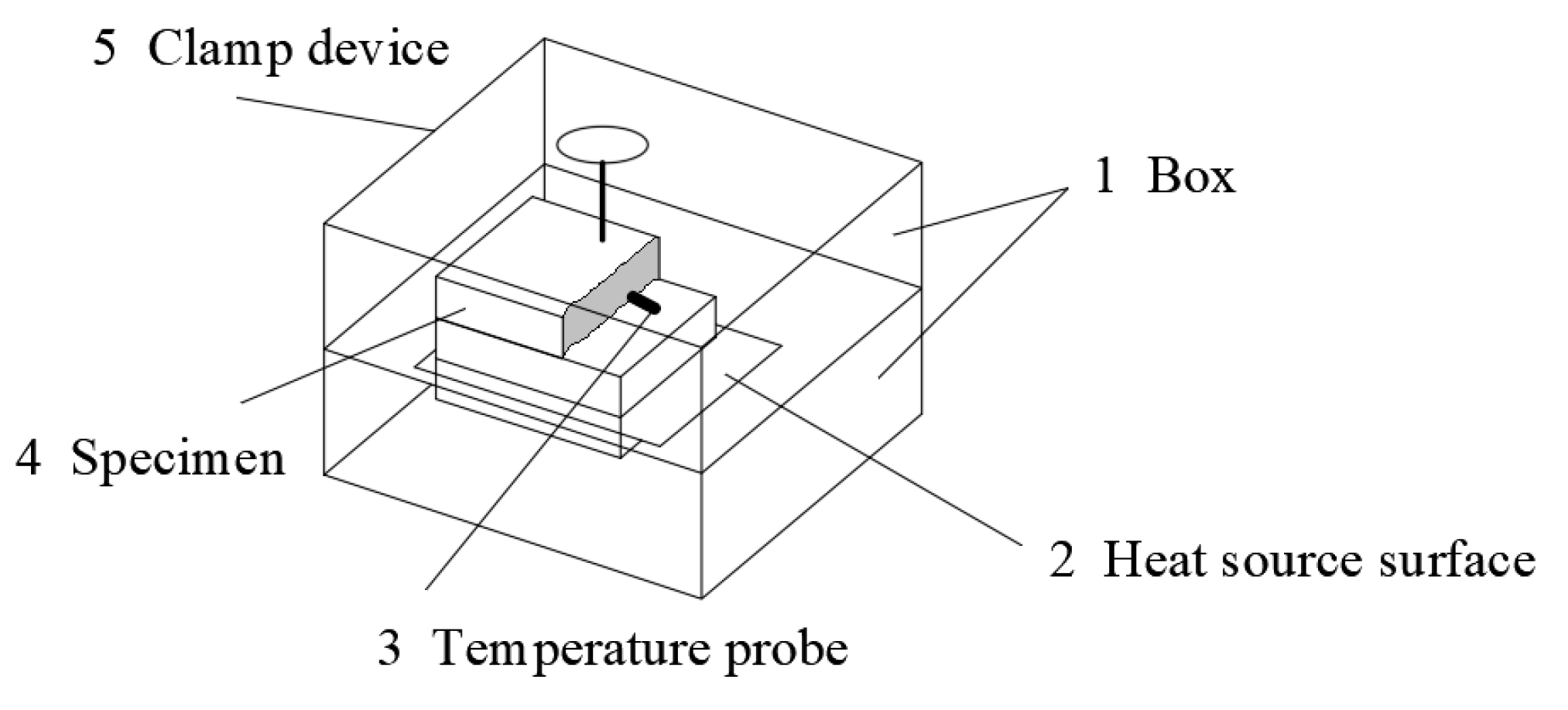
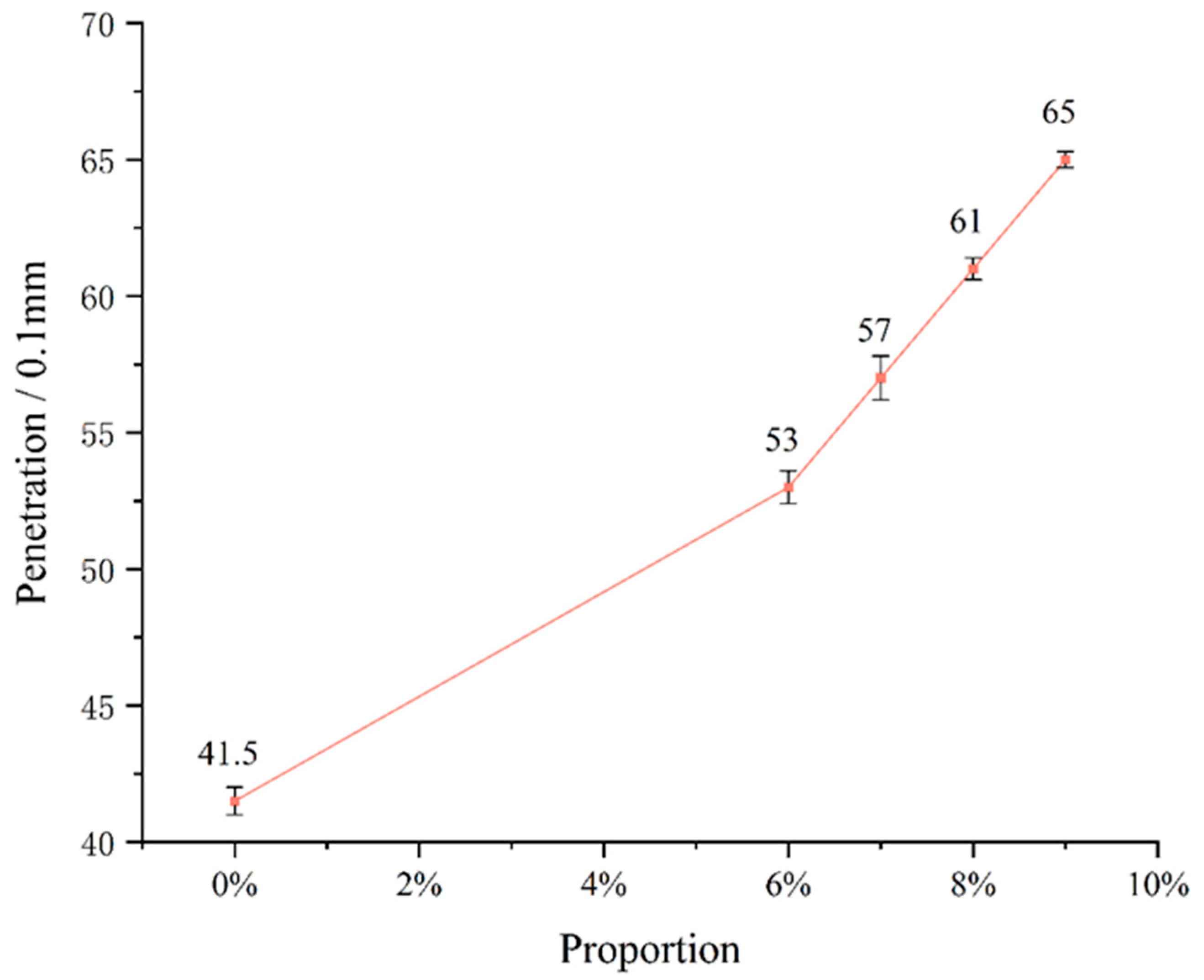
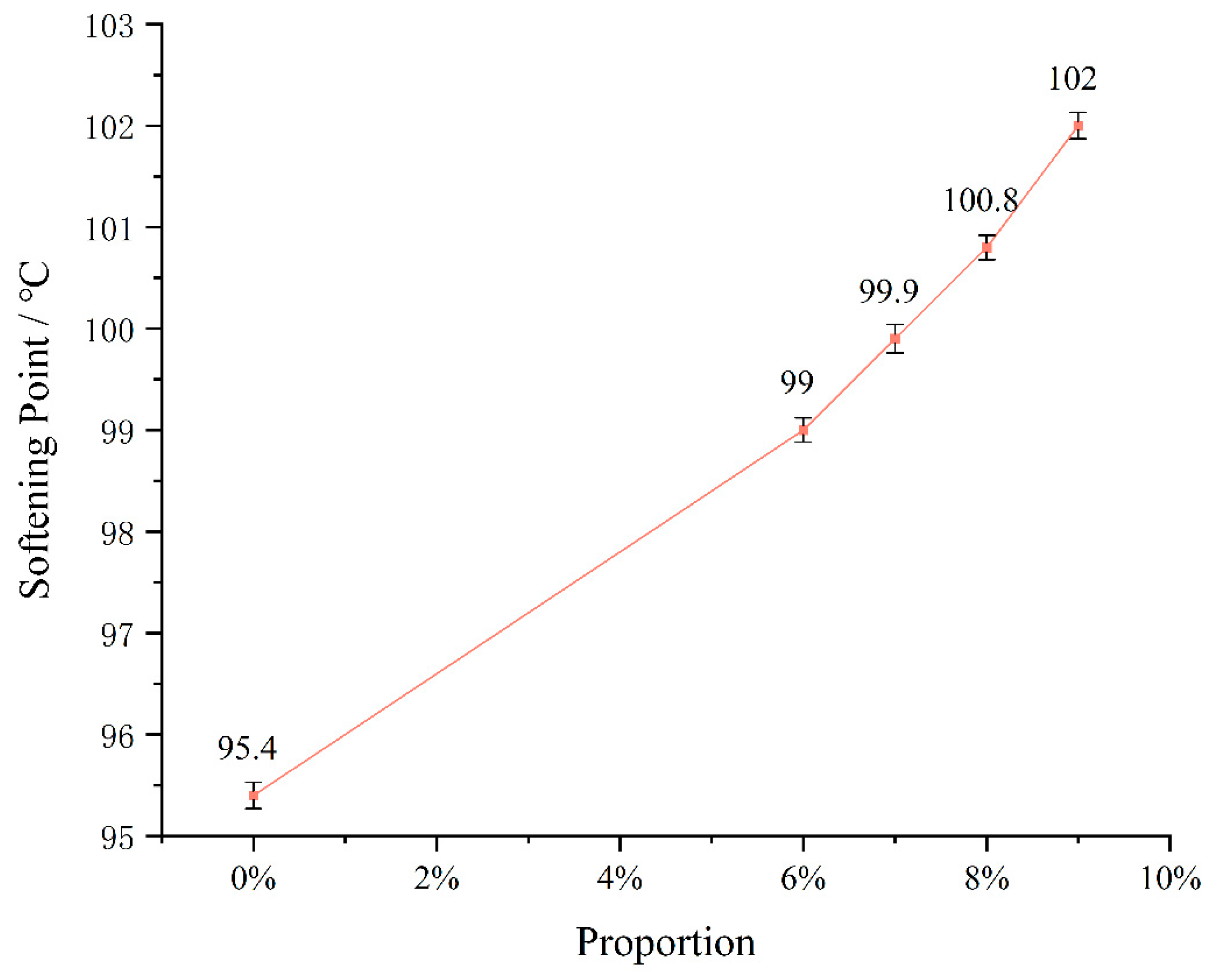
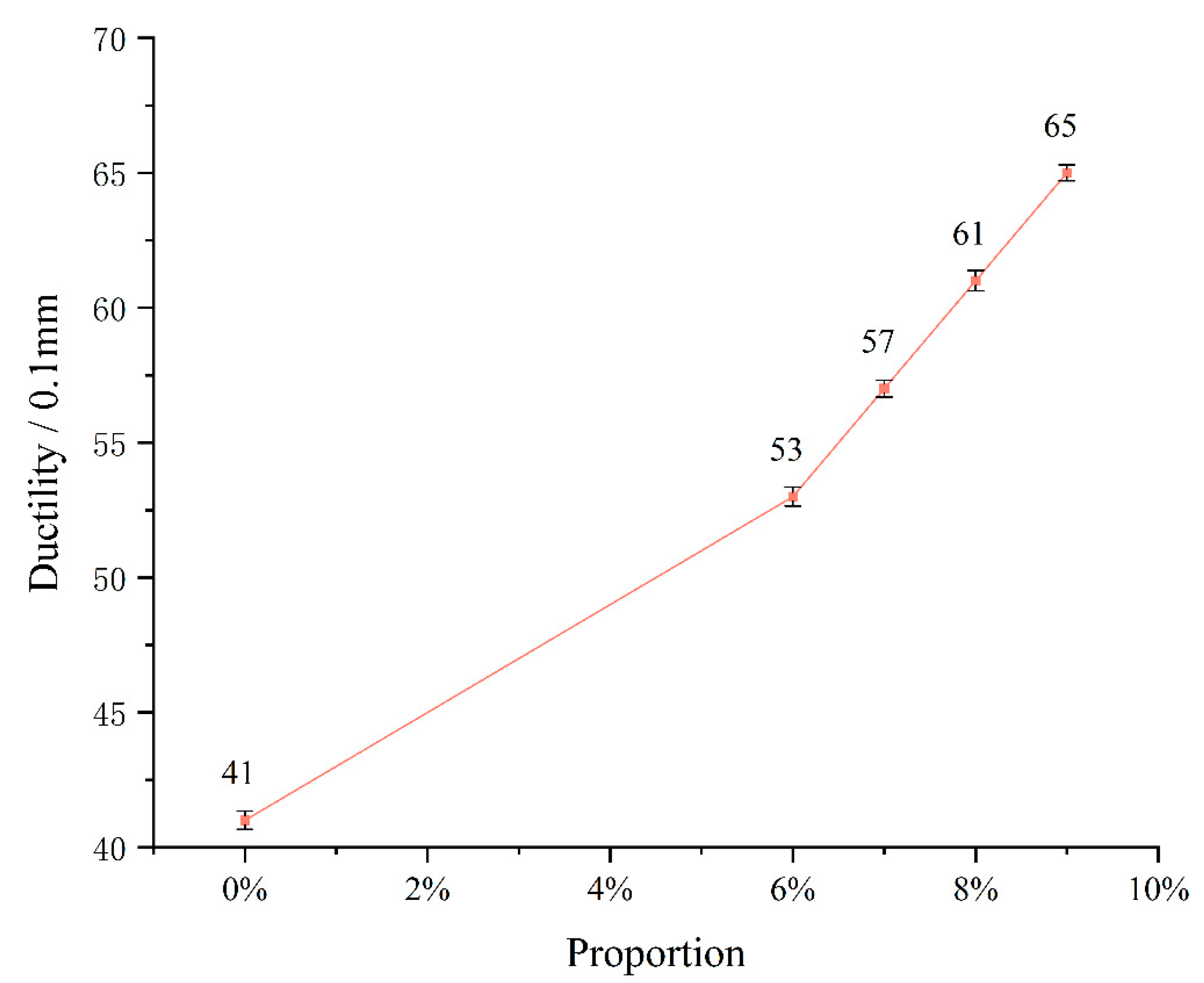





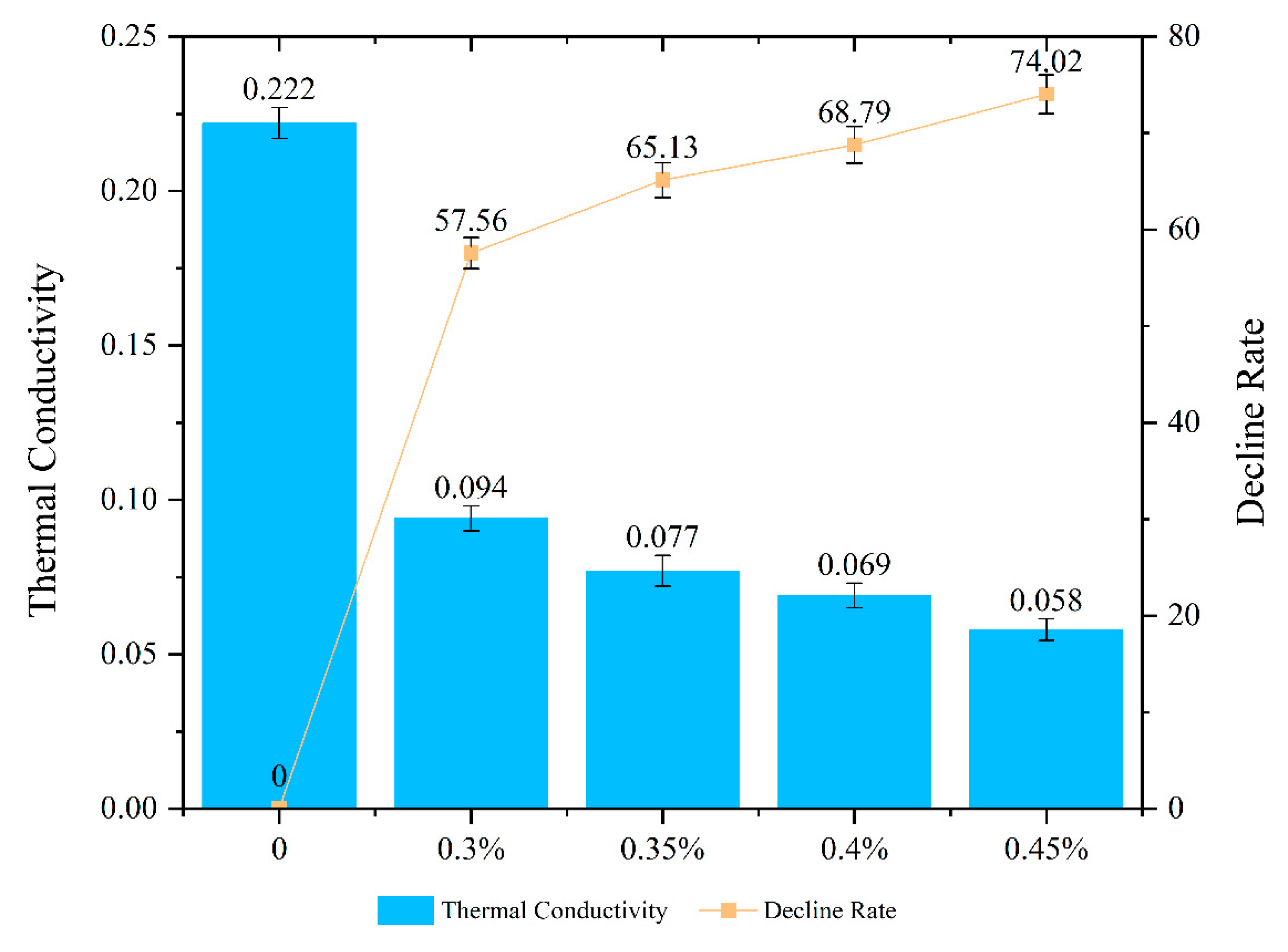

| Name | Molecular Formula | Molecular Weight | Purity/% | Melting Point/°C | Enthalpy of Phase Transformation/(J/g) |
|---|---|---|---|---|---|
| Dodecane | C12H26 | 173 | 98 | −11 | 212 |
| Tetradecane | C14H30 | 196 | 98 | 7 | 218.4 |
| Hexadecane | C16H34 | 231 | 98 | 18.3 | 214 |
| Test Items | Quality Indicators | Test Results | |
|---|---|---|---|
| Penetration (25 °C, 100 g, 5 s)/0.1 mm | 60~80 | 72 | |
| Penetration index | −1.5~+1.0 | −1.0 | |
| Softening point (Ring and ball method) | ≮46 | 48.2 | |
| Power viscosity of 60 °C/Pa·S | ≮180 | 216 | |
| Viscosity of 10 °C (5 cm/min)/cm | ≮20 | 36 | |
| Viscosity of 15 °C (5 cm/min)/cm | ≮100 | >140 | |
| Wax content (Distillation)/% | ≯2.2 | 1.7 | |
| Flash point (Open)/°C | ≮260 | 289 | |
| Density at 15 °C/g/cm3 | Measured | 1.01 | |
| Solubility (Trichloroethylene)/% | ≮99.5 | 99.95 | |
| After short-term aging of TFOT | Quality change/% | ≯±0.8 | −0.07 |
| Penetration ratio/% | ≮61 | 68.8 | |
| Ductility of 5 °C | ≮6 | 7 | |
| Technical Indicators | Particles Size of Coarse Aggregate | |||
|---|---|---|---|---|
| 10~20 mm | 5~10 mm | 3~5 mm | Specification Value | |
| Gross volume relative density | 2.701 | 2.712 | 2.726 | Measured |
| Apparent relative density | 2.73 | 2.75 | 2.79 | ≥2.60 |
| Water absorption rate (%) | 0.83 | 0.67 | 0.58 | ≤2.0 |
| Particle content less than 0.075 mm (%) | 0.3 | 0.5 | 0.7 | ≤1 |
| Content of needle and flake particles (%) | ≤15 | |||
| Particle size > 9.5 mm (%) | 7.8 | 6.3 | / | ≤12 |
| Particle size < 9.5 mm (%) | ≤18 | |||
| Adhesion to asphalt | 5 | ≥5 | ||
| Robustness (%) | 2 | ≤12 | ||
| Crushing value of stone (%) | 15.2 | ≤26 | ||
| Polished stone value | 48 | ≥42 | ||
| Los Angeles abrasion loss (%) | 19 | ≤28 | ||
| Technical Indicators | Test Value | Specification Value |
|---|---|---|
| Apparent relative density | 2.67 | ≥2.50 |
| Angularity (s) | 34.8 | ≥30 |
| Sand equivalent (>0.3 mm part) (%) | 83 | ≥60 |
| Particle content less than 0.075 mm (%) | 1.5 | ≤3 |
| Technical Indicators | Test Value | Specification Value | |
|---|---|---|---|
| Water content (%) | 0.6 | ≤1 | |
| Hydrophilicity coefficient | 0.77 | <1 | |
| Plasticity index (%) | 3 | <4 | |
| Apparent density (t/m3) | 2.664 | ≥2.5 | |
| Thermal stability | No discoloration | Measured | |
| Particle size range | <0.6 mm | 100 | 100 |
| <0.15 mm | 95 | 90~100 | |
| <0.075 mm | 92 | 75~100 | |
| Test Type | Control Model | Specimen Size | Test Parameters | ||
|---|---|---|---|---|---|
| Specimen Diameter/mm | Specimen Thickness/mm | ||||
| High-temperature classification | Original asphalt | Strain | 25 | 1 | Strain value γ = 12%, Test frequency ω = 10 rad/s |
| TFOT residue | Strain | 25 | 1 | Strain value γ = 10%, Test frequency ω = 10 rad/s | |
| PAV residue | Strain | 8 | 2 | Strain value γ = 1%, Test frequency ω = 10 rad/s | |
| Low-temperature classification | — | (127 ± 2) mm × (6.35 ± 0.05) mm × (12.7 ± 0.05) mm | Testing load: 980 mN ± 50 mN | ||
| Temperature scanning | Stress | 25 | 1 | ω = 10 rad/s, τ = 0.1 KPa, T = 30–80 °C | |
| Frequency scan | Strain | 8 | 2 | ω = 0.1~100 rad/s, γ = 0.1 KPa, T = 5 °C, 20 °C, 35 °C | |
| Multiple Stress Creep and Recovery (MSCR) | Stress | 25 | 1 | Phase 1 τ = 0.1 Kpa, Phase 2 τ = 3.2 Kpa; each phase was cycled 10 times, with each cycle loading for 1 s and unloading for 9 s. | |
| Dosage (%) | Penetration (0.1 mm) | Ductility (cm) | Softening Point (°C) | Dynamic Viscosity (N·s/m2) |
|---|---|---|---|---|
| 0 | 41.20 | 35.80 | 95.35 | 224,524 |
| 6 | 53.30 | 56.73 | 98.95 | 277,476 |
| 7 | 57.60 | 64.00 | 99.85 | 354,205 |
| 8 | 61.10 | 69.33 | 100.75 | 532,692 |
| 9 | 65.07 | 72.80 | 101.95 | 569,813 |
| Number | 30 min | 60 min | 90 min | 120 min | 180 min |
|---|---|---|---|---|---|
| 1# | The upper layer froze, and there was a large amount of water under the ice, making the ice more brittle | The upper layer froze, and there was less water under the ice, and the ice was slightly brittle | The upper layer froze, with almost no water, and the ice was slightly hard | The upper layer was completely frozen, and there was almost no water under the ice, making the ice hard | Completely frozen, and the ice layer was hard |
| 2# | The upper layer had relatively thin ice, and there was a large amount of water under the ice, which was brittle | The upper layer froze, and there was a small amount of water under the ice, which was slightly brittle | Ice on the upper layer, trace water below the ice, slightly hard ice | The upper layer froze, and there was almost no water under the ice, making it hard | Completely frozen, and the ice layer was hard |
| 3# | The upper layer had relatively thin ice, and there was a large amount of water under the ice, which was brittle | The upper layer froze, and there was a small amount of water under the ice, which was slightly brittle | Ice on the upper layer, trace water below the ice, slightly hard ice | The upper layer froze, and there was almost no water under the ice, and the ice was slightly hard | Completely frozen, and the ice layer was hard |
| 4# | The upper layer had thin ice, and there was a large amount of water under the ice, which was very brittle | The upper layer froze, and there was more water under the ice, making the ice more brittle | The upper layer froze, with a small amount of water under the ice, and the ice was slightly brittle | The upper layer was frozen with trace amounts of water, and the ice was slightly hard | Completely frozen, and the ice layer was hard |
| 5# | The upper layer had thin ice, and there was a large amount of water under the ice, which was very brittle | The upper layer froze, and there was a lot of water under the ice, making it brittle | The upper layer froze, with a small amount of water under the ice, and the ice was slightly brittle | The upper layer was frozen with trace amounts of water, and the ice was slightly hard | Completely frozen, and the ice layer was hard |
| Number | 30 min | 60 min | 90 min | 120 min | 180 min |
|---|---|---|---|---|---|
| 1# | The upper layer froze, and there was less water under the ice, and the ice was more brittle | Ice on the upper layer, trace water below the ice, slightly hard ice | The upper layer was completely frozen, with almost no water, and the ice was relatively hard | The upper layer was completely frozen, and the ice was hard | Completely frozen, ice hard |
| 2# | The upper layer froze, with a small amount of water below the ice, making the ice more brittle | Ice on the upper layer, trace water below the ice, slightly brittle ice | The upper layer froze, with almost no water, and the ice was slightly hard | The upper layer was completely frozen, with almost no water, and the ice was hard | Completely frozen, ice hard |
| 3# | The upper layer froze, with a small amount of water below the ice, making the ice more brittle | The upper layer froze, and there was less water under the ice, and the ice was slightly brittle | The upper layer was frozen with trace amounts of water, and the ice was slightly hard | The upper layer was completely frozen, with almost no water, and the ice was relatively hard | Completely frozen, ice hard |
| 4# | The upper layer froze, and there was more water under the ice, and the ice was brittle | The upper layer of ice was brittle with a small amount of water | The upper layer froze with less water, and the ice was slightly hard | The upper layer was completely frozen, with almost no ice, and the ice was relatively hard | Completely frozen, ice hard |
| 5# | Thin ice formed on the upper layer, with a large amount of water under the ice, making the ice brittle | The upper layer of ice was brittle and contained more water | The upper layer froze with a small amount of water, and the ice was slightly brittle | The upper layer froze, with almost no water, and the ice was relatively hard | Completely frozen, ice hard |
| 58 | 64 | 70 | 76 | 82 | 88 | 94 | |
|---|---|---|---|---|---|---|---|
| 0% | 26.30 | 14.80 | 8.96 | 5.97 | 4.31 | 3.24 | 2.51 |
| 6% | 26.70 | 15.40 | 9.71 | 6.85 | 5.17 | 4.02 | 3.51 |
| 7% | 27.30 | 15.70 | 9.98 | 7.29 | 5.61 | 4.39 | 3.42 |
| 8% | 28.60 | 16.20 | 10.50 | 7.84 | 6.18 | 4.88 | 3.76 |
| 9% | 29.60 | 17.80 | 12.20 | 9.32 | 7.45 | 5.99 | 4.76 |
| Dosage | −12 °C | −18 °C | −24 °C | Grading | |||
|---|---|---|---|---|---|---|---|
| S (MPa) | m | S (MPa) | m | S (MPa) | m | ||
| 0% | 147.0 | 0.324 | 324.5 | 0.249 | 527.5 | 0.196 | 22 |
| 6% | 96.2 | 0.334 | 221.5 | 0.277 | 397.0 | 0.222 | 22 |
| 7% | 78.5 | 0.345 | 181.0 | 0.290 | 327.0 | 0.228 | 22 |
| 8% | 76.6 | 0.368 | 169.5 | 0.307 | 301.5 | 0.268 | 28 |
| 9% | 63.6 | 0.377 | 132.5 | 0.333 | 235.5 | 0.288 | 28 |
| Test Items | Unit | 0 | 0.3% | 0.35% | 0.4% | 0.45% |
|---|---|---|---|---|---|---|
| Void rate (volumetric method) | % | 22.1 | 22.0 | 21.8 | 22.3 | 22.0 |
| Marshall stability | kN | 8.43 | 7.35 | 7.04 | 6.63 | 6.23 |
| Dynamic stability of rutting test | Times/mm | 9115 | 8091 | 7724 | 5724 | 5371 |
| Residual stability of immersion Marshall test | % | 93.4 | 97.7 | 97.1 | 99.5 | 99.4 |
| Strength ratio of freeze–thaw splitting test | % | 90.3 | 98.9 | 99.3 | 99.1 | 99.5 |
| Low-temperature bending test failure strain | μω | 2870 | 3396 | 4270 | 5329 | 5775 |
Disclaimer/Publisher’s Note: The statements, opinions and data contained in all publications are solely those of the individual author(s) and contributor(s) and not of MDPI and/or the editor(s). MDPI and/or the editor(s) disclaim responsibility for any injury to people or property resulting from any ideas, methods, instructions or products referred to in the content. |
© 2023 by the authors. Licensee MDPI, Basel, Switzerland. This article is an open access article distributed under the terms and conditions of the Creative Commons Attribution (CC BY) license (https://creativecommons.org/licenses/by/4.0/).
Share and Cite
Liu, S.; Zhang, G.; Gao, A.; Niu, Q.; Xie, S.; Xu, B.; Pan, B. Study on the Performance of Phase-Change Self-Regulating Permeable Asphalt Pavement. Buildings 2023, 13, 2699. https://doi.org/10.3390/buildings13112699
Liu S, Zhang G, Gao A, Niu Q, Xie S, Xu B, Pan B. Study on the Performance of Phase-Change Self-Regulating Permeable Asphalt Pavement. Buildings. 2023; 13(11):2699. https://doi.org/10.3390/buildings13112699
Chicago/Turabian StyleLiu, Shaohua, Gong Zhang, Aodong Gao, Qian Niu, Shuai Xie, Bin Xu, and Baofeng Pan. 2023. "Study on the Performance of Phase-Change Self-Regulating Permeable Asphalt Pavement" Buildings 13, no. 11: 2699. https://doi.org/10.3390/buildings13112699





